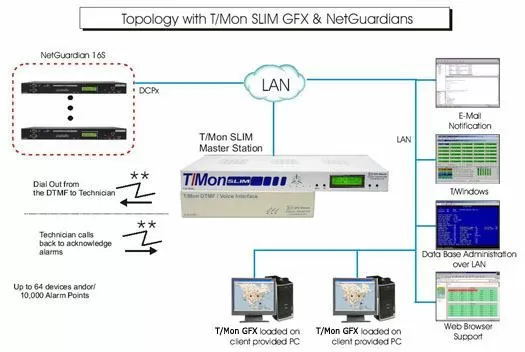Check out our White Paper Series!
A complete library of helpful advice and survival guides for every aspect of system monitoring and control.
1-800-693-0351
Have a specific question? Ask our team of expert engineers and get a specific answer!
Sign up for the next DPS Factory Training!

Whether you're new to our equipment or you've used it for years, DPS factory training is the best way to get more from your monitoring.
Reserve Your Seat Today
Overcome your cell phone coverage degradation issues by using this DTMF verbal 'call-out' feature. The T/Mon SLIM will act as your central alarm aggregation point and provide a means of directly reporting and databasing your alarms. The primary means of reporting alarms will be from the NetGuardians reporting DCPx alarms over IP to the T/Mon SLIM. The T/Mon SLIM is configured with a POTS modem, so it can continue to receive alarm data from the deployed NetGuardians (alternative path reporting) in the event of LAN failure.
After receiving an alarm notification, your technician can take advantage of the T/Mon SLIM web browser interface. Simply logon from virtually any PC with Internet access and get real time alarm-traffic status. In addition, the T/Mon SLIM will be able to send email (SMS) alarm messages to technician cell phones or use the DTMF Voice box for verbal notification. Verbal notification will be achieved through a limited, non-changeable vocabulary that you will have the ability to select from to "build" the notification message. When the DTMF voice box dials out, the person called will get an announcement and be asked to authenticate himself. After the code is successfully entered, the verbal message will then be delivered. At this time, the on-call person may acknowledge or silence that particular alarm.
This solution also features our original DTMF call back solution as well. The DTMF/Voice Interface for T/Mon lets you acknowledge or silence alarms from the field, using any touch-tone / cell phone. As easy and familiar as a voice-mail system, the DTMF Voice Interface uses recorded voice prompts to guide you through a menu of options, and you just select your choice by pressing a phone button. T/Mon keeps track of who acknowledges the alarms over the phone. This device, as described above, will be responsible for the "verbal dial out". With a maximum capacity of 64 network devices, the T/Mon SLIM will be able to monitor all of your NetGuardian remotes and other RTUs - all without the need of additional software! Each address / port location will take up one device in the T/Mon SLIM capacity.
The T/Mon GFX Software Module is a graphic-based application that is great for T/Mon applications where intuitive graphical monitoring is required. T/Mon GFX provides a graphic display of alarm network status using maps, floor plans and other graphic representations to give operators a system visibility. T/Mon GFX can work using a centralized database across the LAN where multiple users can access the same information. Multiple T/Mon GFX displays can be supported by T/Mon software. T/Mon GFX will run on a windows based PC connected to the T/Mon SLIM via LAN and consists of a series of maps that allow users to have a birds eye view of their network. Users can then drill down on specific icons representing layers of your network. Layers could include a national, regional, local view and even a rack presentation of your equipment. It's very intuitive for the users and makes for a very impressive war room type display. Mapping software is included that reflect your local area but you may also use any graphic that can be saved as a .bmp extension.